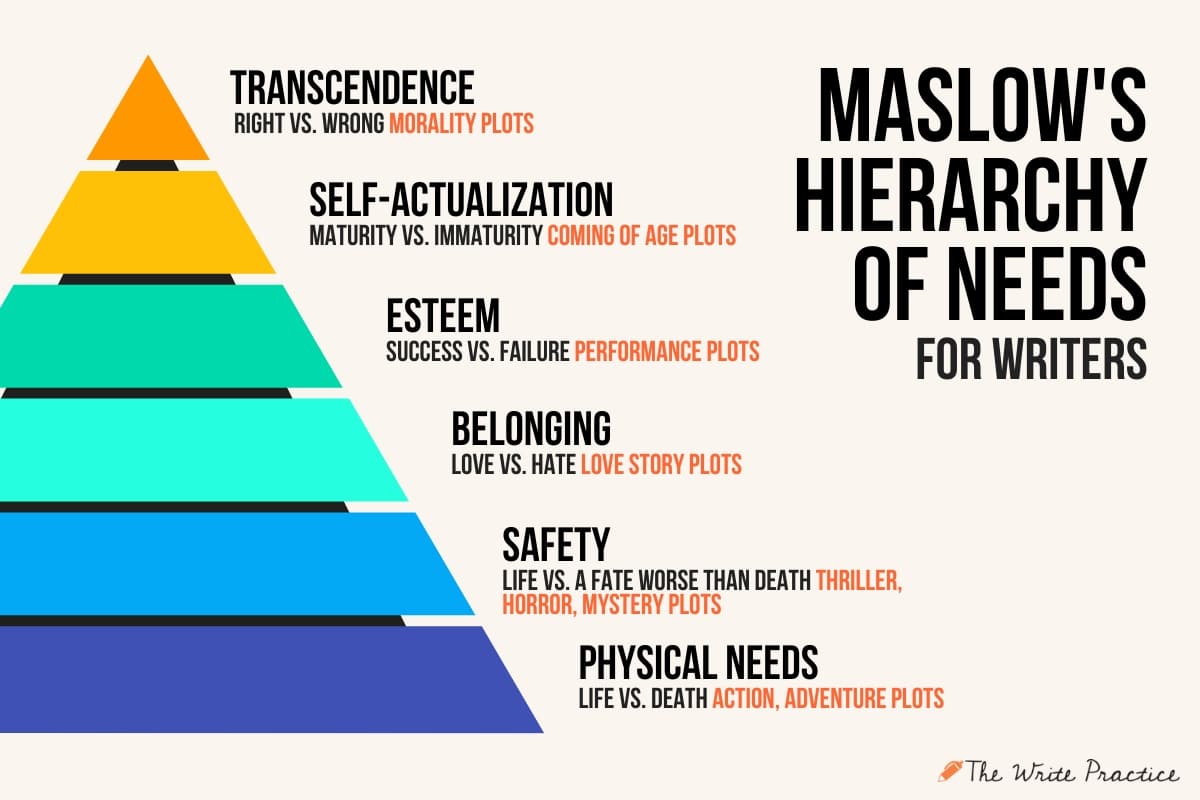Few things are more exciting than an action story. The high stakes, the high-speed chases, the high-octane moment when the protagonist finally faces the bad guy in an epic battle scene—action stories will have you on the edge of your seat until the very end. Today, we’re going to look at how to write an action story that has your character’s (and reader’s!) heart racing.

Value Scale
Action stories are one of the ten types of stories that we’ve been exploring (check out our full guide on plot types here.) Each of these plot types is based on a specific value scale, as you can see in the diagram of Moslow's Hierachy of Needs below:

- Survival from Nature > Life vs. Death
- Survival from Others > Life vs. Fate Worse than Death
- Love/Community > Love vs. Hate
- Esteem > Accomplishment vs. Failure
- Personal Growth > Maturity vs. Immaturity
- Transcendence > Right vs. Wrong
Life vs. Death
Like adventure stories, the value scale in action stories is life vs. death. However, while adventure stories usually revolve around a MacGuffin (an important object, place, or person that sets the plot in motion), actions stories usually involve a specific antagonist that the protagonist must defeat. This antagonist could be a person, natural occurrence, creature, or some other external force.
It's important to note that while there is an action genre, these plot types are not restricted by literary genre. For example, you can have an action thriller story, a horror action story, or a fantasy action story. All you need to remember is that the action story type is based on the value of survival and life vs. death.
Not sure what your story's plot type is? Take our free plot type test here.
Conventions
Action stories will usually include some, or even all, of the following conventions:
- A villain and/or natural force
- A deadline, timer, or some kind of countdown
- A sidekick of team that helps the protagonist
- Chase scenes, fight scenes, and other exciting action scenes
- Elements of suspense
There are several subtypes of action stories, including revenge plots, natural disaster, military/war, and superhero stories.
Action Story Archetypes
Inciting Incident
Action stories usually start with a bang (sometimes literally!), and tend to use one of the following inciting incident archetypes:
1. The emergence of a great evil. In this archetype, a great evil arrives that threatens the world, or the world as the protagonist knows it. This great evil could be anything, such as a villain, a force of nature or disaster, a creature, or something else entirely. The protagonist must then spring into action to stop it.
2. Great crime against me. Here, the protagonist was the victim of a crime, wrong, or other evil act—often by the villain. This then spurs the protagonist on to make things right again, or even seek revenge for what happened to them.
Climax
Following the inciting incident, the protagonist will overcome various obstacles in the rising action before facing a dilemma, leading to an exciting climax that leaves the reader breathless.
The climax archetype in action stories is usually a showdown with the villain, where the protagonist finally confronts the antagonist. The climax in an action story is often dramatic, tense, and fast-paced. The protagonist might even suffer some kind of terrible injury in the process.
The protagonist will (usually) win, though, putting a stop to the great evil or righting the terrible wrong they suffered at the hands of the villain.
Tips to Write a Strong Action Story
Pacing
Action stories are usually fast-paced, exciting, and full of tension. Here are some tips on how to keep your pacing strong and avoid your scenes lagging.
External Pressure
Adding some kind of external pressure, such as a countdown, is a surefire way to keep your pacing steady and your tension high. Throw as many obstacles and disruptions in your character’s way as you can, so they have to work hard to defeat the bad guy in a very short amount of time.
Make Sure Your Character Acts
Character development and internal dialog are incredibly important, but don’t let your characters spend all their time thinking or talking. They need to do something, too. Show us their actions and movements, using strong, precise, and active verbs.
Sharp Descriptions
Similarly, keep your descriptions focused and relevant. Your readers need to be able to visualize the scene, and it's always important to add enough sensory details to bring your setting to life. However, spending too much time on unnecessary and overly detailed descriptions during important moments can derail the scene fast and make you lose all the momentum you've built.
Instead of simply describing the area around your character, have them engage with their world. Cut all mundane details and focus on what's important to their survival. For example, instead of noting the coffee mug on the villain's desk, your protagonist could notice the locked drawer or a strange tapping down the hall. Use your descriptions to add even more tension and suspense. This will keep your scenes crisp, concise, and clear–and your story moving.
Short, Concise Sentences
Finally, the action writing style is usually filled with punchy, shorter sentences. Don’t let your character (or reader) become distracted—trim every word you don’t need to build a sense of urgency and danger.
Use Active Voice
Passive characters rarely make good action heroes, and the same goes for a passive writing style. To keep your reader engaged and your tension high, make sure your characters—and writing—are active. Your character should take charge of what's happening, rather than letting the action happen to them, and your writing should reflect that.
Focus on Your Chain of Events
Fight scenes and other action sequences can quickly spiral out of control and become confusing—or worse, boring. To keep your story’s momentum going, focus on your chain of events, with one action leading directly to another, and don’t get side-tracked. The character’s goal—to defeat the bad guy—should always be at the forefront of their mind.
Famous Action Stories
There are many famous examples of action stories, including:
- The Count of Monte Cristo by Alexander Dumas
- Hunger Games by Suzanne Collins
- Die Hard (film)
- Casino Royale by Ian Fleming
- The Hunt for Red October by Tom Clancy
These are not only entertaining and exciting stories, but they're also a great way to learn from the masters about how to write effective action scenes. The best writers are readers as well, so if you're interested in writing an action story, check out some of these books and films and see what works for you as a reader.
The Protagonist’s Life on the Line
Action stories can be incredibly versatile, with the protagonist battling any number of external threats. The important thing to remember is to make sure the protagonist’s life is always on the line. This will naturally build to an incredibly tense and exciting climax, where the protagonist faces that threat head on. And, if you choose it, they might even survive.
Want to practice your action story skills? Check out our action story ideas here.
What’s your favorite action story? Let us know in the comments!
PRACTICE
Set the timer for 15 minutes. Write a scene where your protagonist faces either a villain or some other great force like a fierce creature. Make sure there is a genuine threat to the protagonist’s life in this scene, and ramp up the tension as much as you can.
When you're finished, share your story in the Pro Practice Workshop for feedback from the community. Remember to give feedback to three other writers too. Not a member yet? Join us here.
Happy writing!
Elizabeth Nettleton is an author and editor currently based in Oxfordshire, England. An avid reader and writer since childhood, she was once so engrossed in her book that she ran into a lamppost.
There is nothing Elizabeth loves more than magic and getting lost in other worlds (except for her family, friends, and pets, of course!), so she primarily writes fantasy, sci-fi, and horror. When she's not reading or writing, you can find her playing with her kids, daydreaming, or trying not to die in a video game.
You can learn more about Elizabeth's projects on her website, or say hello to her on X here.
0 Comments